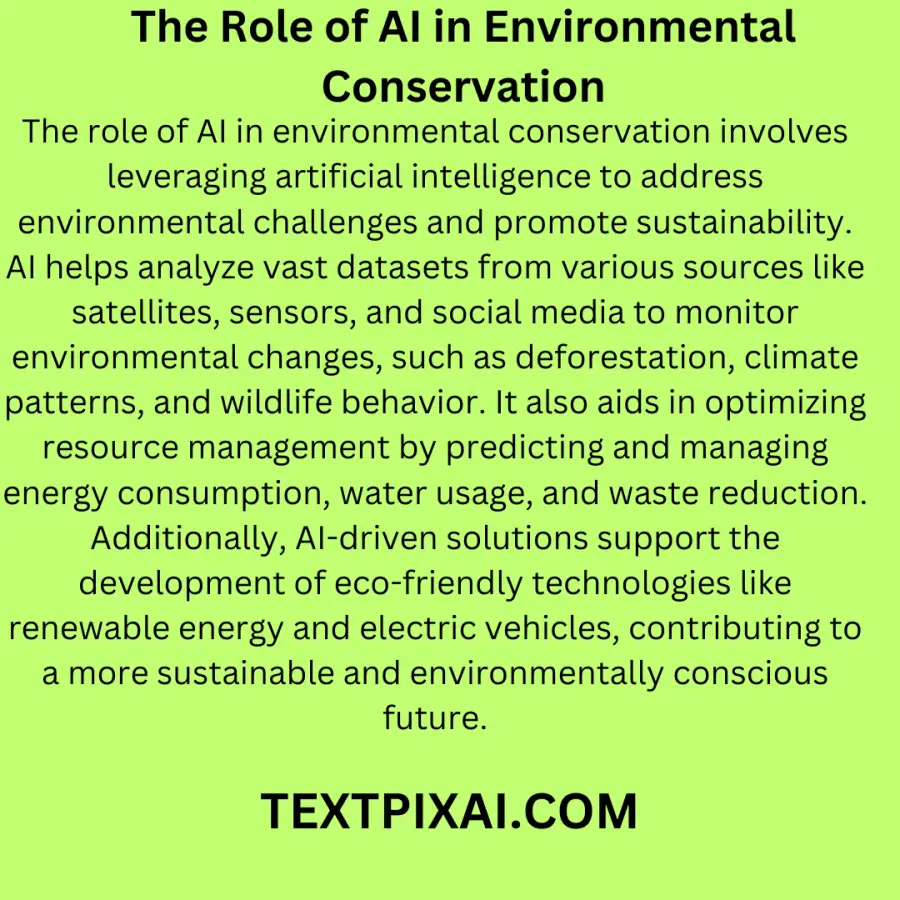The Role of AI in Environmental Conservation
Introduction
As our planet faces unprecedented environmental challenges, the integration of AI technology into conservation efforts couldn't have come at a more crucial time. AI's ability to process vast amounts of data quickly and accurately has revolutionized the way we approach conservation.
Wildlife Tracking and Protection
AI-Powered Camera Traps
One of the most exciting applications of AI in wildlife conservation is the use of AI-powered camera traps. These devices can identify and classify animals based on their appearance, behavior, and movement patterns. This technology helps scientists gather valuable data on endangered species and monitor their populations.
Poaching Prevention
AI algorithms are being used to detect and deter poaching activities. These systems can identify potential threats in real-time, such as unauthorized human presence in protected areas, and alert authorities, enabling swift intervention to protect wildlife.
You may also like to read:
Predictive Analytics for Conservation
AI's predictive capabilities are being harnessed to anticipate environmental changes and their impacts on ecosystems. By analyzing data from various sources, AI can predict trends in wildlife behavior, identify potential habitat threats, and even foresee the spread of diseases among animals.
Sustainable Agriculture
AI-driven precision agriculture is promoting sustainable farming practices. Farmers can optimize resource usage, reduce waste, and increase crop yields through AI-powered monitoring systems that provide real-time data on soil conditions, weather, and crop health.
Climate Change Mitigation
Carbon Footprint Reduction
AI is aiding in the reduction of carbon footprints by optimizing energy consumption in industries, managing transportation systems more efficiently, and helping design eco-friendly buildings. These efforts contribute significantly to combatting climate change.
Climate Modeling
AI-driven climate models can simulate various scenarios, helping scientists and policymakers make informed decisions about climate change mitigation and adaptation strategies.
Monitoring and Managing Natural Resources
AI is invaluable in monitoring natural resources, such as forests and oceans. It can detect illegal logging, track deforestation rates, and even analyze water quality in real-time, ensuring the sustainable management of vital ecosystems.
The Role of Drones in Conservation
Drones equipped with AI technology are being used for aerial surveys, wildlife monitoring, and even reforestation efforts. These unmanned aerial vehicles provide a bird's-eye view of remote areas, facilitating conservation initiatives.
Challenges and Ethical Considerations
While AI offers tremendous promise in conservation, it also presents challenges. Ensuring ethical AI usage, protecting data privacy, and addressing biases in AI algorithms are critical aspects that require careful consideration.
AI's Contribution to Public Awareness
AI can create engaging, data-driven visualizations and interactive tools that educate the public about environmental issues. This not only raises awareness but also fosters a sense of responsibility towards our planet.
Future Prospects
The future of AI in environmental conservation is bright. With ongoing advancements in AI technology, we can expect more innovative applications, improved accuracy, and increased collaboration between AI experts and environmentalists.
Conclusion
AI has evolved into a powerful tool in the fight to preserve our planet. From safeguarding wildlife to mitigating climate change, its contributions to environmental conservation are invaluable. As we move forward, responsible and ethical AI usage will be paramount in harnessing its full potential.
Finally, AI is not just a technological marvel; it's a lifeline for our planet's conservation efforts. As it continues to evolve, AI's role in environmental conservation will undoubtedly become even more pivotal, offering hope for a greener and more sustainable future.
FAQs
1. How does AI help protect endangered species?
AI assists in protecting endangered species by monitoring their habitats, detecting threats, and providing real-time alerts to conservation authorities, enabling timely intervention.
2. What role does AI play in sustainable agriculture?
AI in agriculture enhances sustainability by optimizing resource use, monitoring crop health, and improving yields, leading to reduced environmental impact.
3. How can AI combat climate change?
AI combats climate change by optimizing energy consumption, aiding in climate modeling, and facilitating the development of eco-friendly technologies and practices.
4. Are there any ethical concerns with AI in conservation?
Yes, ethical concerns include data privacy, algorithm biases, and ensuring AI usage respects human and environmental rights.
5. What can we expect from AI in environmental conservation in the future?
We can expect AI to play an increasingly significant role, with more innovative applications, improved accuracy, and enhanced collaboration between AI experts and environmentalists to address pressing conservation challenges.








